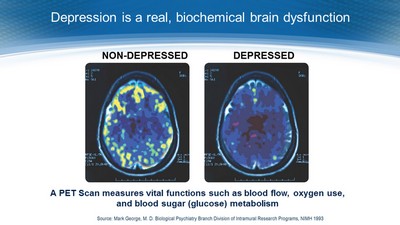|
The medical term meaning "cause" is [etiology]. As you talk to a physician or research on the causes of depression knowing this term will come in handy. Most likely, the etiology of depression is a combination of genetic, biological, environmental, and psychological factors.
Depressive pathologies are disorders of the brain. Brain-imaging technologies, such as Magnetic Resonance Imaging (MRI), have shown that the brains of patients who have depression are physically different than those of non-depressed individuals. This is important to understand. A depression patient is not a "mental" or "crazy" person in the fact that there is an underlying physical brain disorder causing the depression. They are not "faking it" and the treatment must look into getting the brain back into a normal physical pattern.
The following images show a Positron Emission Tomography (PET) scan of both a non-depressed and a depressed individuals. In these images the areas of the brain involved in mood, thinking, sleep, appetite, and behavior appear different. These images do not reveal why the depression has occurred, only that a depressed brain is physically different from a non-depressed brain.
Click on the image for a larger view
Some types of depression tend to run in families, indicating a genetic base for the pathology. However, depression can occur in people without family history of depression. Scientists are studying certain genes that may make some people more prone to depression. Some genetics research indicates that risk for depression results from the influence of several genes acting together with environmental or other factors. In addition, trauma, the loss of a loved one, a difficult relationship, long winter seasons, or any stressful situation may trigger a depressive episode. Other depressive episodes may occur with or without an obvious trigger.
Who is at risk?
Major depressive disorder is one of the most common mental disorders in the United States. Each year about 6.7% of U.S adults experience major depressive disorder. Women are 70 % more likely than men to experience depression during their lifetime. Non-Hispanic blacks are 40% less likely than non-Hispanic whites to experience depression during their lifetime. The average age of onset is 32 years old. Additionally, 3.3% of 13 to 18 year olds have experienced a seriously debilitating depressive disorder.
Depression also may occur with other serious medical illnesses such as heart disease, stroke, cancer, HIV/AIDS, diabetes, and Parkinson's disease. People who have depression along with another medical illness tend to have more severe symptoms of both depression and the medical illness, more difficulty adapting to their medical condition, and more medical costs than those who do not have co-existing depression. Treating the depression can also help improve the outcome of treating the co-occurring illness
Source: National Institute of Mental Health
|



